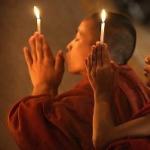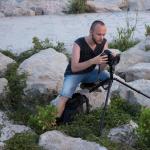A guide to photographing lightning, or how to shoot lightning. How to shoot lightning: useful tips How to photograph lightning on canon
Publication date: 11.08.2015
How to photograph such a fleeting phenomenon as lightning? It would seem that the photographer for this must have some kind of very quick reaction in order to have time to press the shutter button in time. In fact, a quick reaction is not required here.
Nikon D810 / Nikon AF-S 18-35mm f/3.5-4.5G ED Nikkor
Shooting options
To shoot lightning, you need… shutter speed. To capture lightning (or maybe more than one) in the frame, let's try to use our camera as a kind of trap. We select mode S or M on the device and set the shutter speed in it to be more authentic - ideally 30 seconds or more (which is possible with a remote control). Please note that during the day the lighting is too bright, with such slow shutter speeds the frame may be overexposed. To prevent this from happening, it is more convenient to shoot at dusk and at night or use a high-density neutral gray filter. Thus, while the device is shooting at a slow shutter speed, all the lightning that has occurred during this time will fall into your frame. Instead of one shutter speed of tens of seconds, you can set up the device for continuous shooting and take shots with a shutter speed of, say, five seconds.
In the future, all the resulting frames with lightning can be glued into one using Adobe Photoshop. The same can be done with the overlay (multi-exposure) function. This feature is present in advanced cameras from Nikon, we already wrote about it. With this approach, you can place as many lightnings you have caught in one frame. The main condition is that it is necessary to shoot from a tripod so that all the frames to be glued are taken from the same angle.
Necessary equipment
A camera with the ability to make manual settings. It is especially important that it be possible to set a shutter speed of several tens of seconds on it. This criterion is met by modern SLR and mirrorless devices, even the most affordable models, such as Nikon D3300 or Nikon D5500.
Wide angle lens. Take pictures at the minimum focal length with the maximum angle of view. This will cover more of the sky and capture more lightning in the frame. Even a "whale" lens is suitable for such shooting - it allows you to shoot with a very wide viewing angle. The maximum viewing angle is given by specialized ultra-wide-angle lenses. An example of such optics is the Nikon AF-S 10-24mm f/3.5-4.5G ED DX Nikkor for DX cameras and the Nikon AF-S 14-24mm f/2.8G ED for full-frame cameras.
The rest of the items are desirable but not required. Let's list them in order of need.
- Tripod. It is always needed when shooting at slow shutter speeds. A tripod allows you to fix the camera and get a sharp shot. When shooting without it at a slow shutter speed, everything will be smeared. As a tripod, it is permissible to use everything on which the camera can be leaned: a chair, a table, a car hood, a stone, a hillock. The main thing is to ensure the absolute immobility of the apparatus.

- This is a dark glass that cuts off part of the light entering the apparatus. With the help of a neutral gray filter, you can set long exposures even during the day, without fear of overexposure. The optimal filter would be ND64 or denser (ND400, ND1000). Remember the main trick of using a dense dark filter: first compose the frame and focus, then turn off autofocus and only then install an ND filter on the camera. After installing such a dark filter on the camera, you will no longer be able to compose a shot or focus, since nothing will be visible in the viewfinder. If you are shooting a thunderstorm at night or at dusk, you will not need such a filter.

- Remote control. Firstly, it will allow you not to shake the camera at the moment you press the shutter button. Secondly, advanced remote control models allow you to fine-tune ultra-long exposures of several minutes or several hours. We definitely won’t need hourly shutter speeds, but the ability to set shutter speeds of several minutes can come in handy. The specific remote control model is selected depending on the camera you are using. Modern cameras equipped with a Wi-Fi module allow you to use your smartphone as a remote control, which is quite convenient.
Shooting preparation and safety
Check the weather forecast. It will help you know if you should expect a thunderstorm in the near future. It is convenient to shoot thunderstorms in regions where they are common. For example, in the summer in many mountainous areas, thunderstorms can occur almost every day in the afternoon.
For shooting, the best time will be the evening hours after sunset and at night. At this time, you can easily take pictures at slow shutter speeds.
Watch the direction of the clouds, notice from which side a thundercloud may appear. Identify several shooting points that offer a good view in this direction. It is quite possible to find such shooting points, for example, near your country house. Or maybe a beautiful view opens from your balcony in a city high-rise building?…
Practice shows that it is best to photograph a cloud when it is just approaching you, hanging above the horizon. During this period, it will be possible to capture her with all potential lightning in the frame. Directly during a thunderstorm, shooting will be impossible due to rain, poor visibility, strong winds and the danger of being struck by lightning. Shooting locations are best positioned according to safety regulations.
Do not stand with a camera on a tripod in an open field, on hills, under lonely trees.
Don't be discouraged if you can't catch the lightning in the frame the first time. Show restraint: take frame by frame until the end or until a thunderstorm comes to you - it starts to rain and there will be no opportunity to shoot.
Think over where you will hide yourself and hide the device when a cloud comes to you and bursts into a downpour. It is unlikely that it will be possible to shoot lightning in a downpour - the visibility is very low, but the probability of getting the camera wet is high. It is best to hide in a house or at least in a tent. At a minimum, bring a raincoat and a photo bag with an all-weather cover.
July 2008, in the Urals, turned out to be fruitful for thunderstorms. A storm could break out in the evening and last all night, making car alarms go off. The owners jumped up to turn them off, but this did not help, as with another lightning strike, the cars exploded again with sirens. All this was accompanied by colossal flashes, thunder and heavy rain. In general, no one slept, and even more so I. Because I was terribly interested in photographing lightning.
Photographing lightning is difficult, but not impossible. This requires three conditions: a good thunderstorm, a good location for shooting, and a good photographer.
Perhaps the most difficult thing is a suitable point for shooting. Since there is no smoke without fire, ... i.e. thunderstorms without rain, then getting out somewhere on the street with a tripod and a camera is problematic. The most convenient option is a suitable view from the window.
I shot lightning from the windows of my apartment, and it was the most comfortable way. From the equipment you definitely need a tripod. It is desirable to be harder, since long shutter speeds are needed, up to 30 seconds. And the camera itself with the ability to set long exposures. I shot with a Canon 450D DSLR with an 18-55 f 1:3.5-5.6 kit lens.
The essence of the method is that you need to point the camera at the place where lightning flashes, and by setting the shutter speed as long as possible, start shooting. If lightning flashes at this moment, it will clearly appear in the photograph, and during the entire exposure time, the contours of the night landscape will appear.
Since you are shooting blindly, you have to take dozens of shots to catch that one. I shot on a 2Gb card and filled it completely (about a hundred shots in RAW).
I switched the camera to manual mode. The exposure was chosen empirically. ISO 200, shutter speed 30 sec, f 9.
In Canon 450D, there is a cool mode: “Self-timer. Serial" which allows you to take a series of up to 10 frames. 10 frames of 30 seconds, this is 5 minutes of shooting. Thus, I set up the camera, pressed the shutter, and for the next 5 minutes the camera caught all the lightning that fell into its lens.
This is how this photo was taken with a distant lightning that “sets fire” to the city lights:
ISO 200, f9, 30 sec.
The next night there was another thunderstorm. I started shooting at ISO 200, f 8, 30 sec. Which gave a good exposure, until a thunderstorm came close and in one of the series, lightning traced the entire frame from top to bottom, causing severe overexposure. Even the use of RAW did not save. Here is one of the overexposed frames:

ISO 200, f8, 30 sec.
I immediately corrected the exposure and set f 11, shutter speed 20 in the next series took great pictures, here is one of them:

ISO 200, f11, 20 sec.
Removing the zipper during the day turned out to be much more difficult. There is a lot of light, you can’t set a long shutter speed. I shot in RAW and after a couple of shots in a row the camera started to stop to record a frame on a flash drive. According to Murphy's law, it was during these pauses that the most significant lightning flashed. And yet I managed to catch one of them:

ISO 100, f14, 1/4 sec.
To increase the shutter speed, an ND filter would have been suitable, but I didn’t have one then. Perhaps it was worth abandoning the slow RAW during the day and shooting series in jpg.
I recommend shooting in RAW, as it is impossible to accurately select the exposure and white balance in night shooting. Much more accurately, this can be done later in the RAW converter. I use Photoshop Lightroom for this purpose.
Another difficulty of such shooting is pitch darkness. I focused in the car on distant lights, and refined the composition on the first frames. The pictures clearly show the skyline and the outlines of the buildings, but in fact, there was nothing to see there, because it was a deep, overcast night and it was raining. If the wind blows through the window, there is another problem of raindrops that fall on the lens. Here it is worth using a protective filter. On the “daytime” series, the wind blew towards me and I had to constantly wipe the raindrops from the filter.
After those thunderstorms, shooting such phenomena captured me very much. Looking forward to summer to try my luck again. Thinking about where you can find a platform with a beautiful night view, and at the same time with a roof over your head.
Lightning in the lens. "Lightning Cam"
"I love the storm in early May,
When spring, the first thunder,
as if frolicking and playing,
Rumbles in the blue sky."
F. Tyutchev
Now, although it is not the month of May, that very warm time is coming, which undoubtedly cannot but rejoice, and with it picturesque thunderstorms! The application, which will be discussed below, will allow you to capture on your phone those very milliseconds when lightning flashes in the sky and will allow you to show off a great picture.
With the help of the LightningCam application, you can take truly unique photos from your iPhone, because not everyone can boast of real lightning photos.
The essence of the application is quite simple. The main function is automatic lightning photography. Next, I will talk about the application in a little more detail.
At first glance, the interface is quite old-fashioned, but at the same time, the application has recently been updated and has been optimized for new iPhones. By the way, support for the new iPad is also available!
* To start shooting, we are invited to go through small settings to indicate the optimal photos in the climatic conditions around us.
* Choose light now or night outside.
* How far is the storm front from us. We shoot lightning or dangerously close lightning bolts.
* Once the camera is focused, click "Yes".
Now the program is ready to start shooting. Of course, it was possible to select the "Assistant" key from the very beginning and then you would not have to make manual settings, but for sure the developer left the manual input for a reason.
Once you're done, it's ideal to use a tripod to avoid hand shaking. But I took pictures without it and the quality suited me.
As soon as there is a flash of lightning in the sky, the sensor in the camera will instantly react to this and take a photo of the lightning itself.
In my opinion, this functionality for the photo application is quite unique and you can definitely spend money on this application. By the way, for those who want to try everything themselves, there is a free version. Of course, you will not use it every day, but on warm spring and autumn days, it’s quite maybe you will take great photos, an amazing phenomenon like a thunderstorm!
P. With a couple of examples of photos, on the iPhone 5: (now, by the way, the FPS is already different on modern phones, it shoots even cooler)
If you are interested, subscribe, I will try to write more often about outstanding applications.
iLightningCam - Lightning Strike Photography, Florian Stiassny
iLightningCam Lite - Lightning Strike Photography, Florian Stiassny
This is one of the basic rules, which in no case should be forgotten. If you stand on the street, in stormy weather, hung with appliances for a long time, you must remember about your safety. Try to be as far as possible from the epicenter of the hurricane, being at a distance, you will be able to better assess the situation and take a good shot. If you can’t get away from a thunderstorm, then be sure to take care of shelter. If you can't find a safe place on the street, you can take pictures while in the car and open the window.
2. Use a tripod
When shooting lightning, you will shoot at slow shutter speeds, therefore, you simply won’t be able to take pictures of high quality and without a tripod. If a storm caught you by surprise and you didn’t have a tripod, try to come up with a stand for your camera and take pictures from it.
3. Adjust Aperture and Lower ISO
Both of these options allow you to shoot at slower shutter speeds for beautiful, vibrant photos. In this case, we want something a little different, we want to make the pictures a little darker. To do this, you need to close the diaphragm, leaving only a small hole. Let's say your lens has an aperture value between f/2.8 and f/22, try shooting at something like f/11 or f/14. Depending on which camera you have, you can lower the ISO without degrading the image quality.
4. Use a ND filter if necessary
If your camera's aperture and ISO settings still don't allow you to shoot long enough, you can attach an ND filter to the front of the lens. With it, you can reduce the depth of field when shooting a bright subject.
5. Shooting with a long exposure
The best option when shooting lightning would be to shoot for at least ten seconds. After each shot taken, be sure to view the result to check if everything comes out as it should. Perhaps the image is too bright or underexposed, blurry, or you didn't capture the perfect moment at all.
6. Be patient
Taking off a zipper beautifully and with high quality can be an overwhelming task for a beginner, but it's certainly worth trying and learning. When you learn how to properly set up your camera, depending on the time of day, the power of the hurricane, the strength of the wind, etc. you will succeed. As you get more experienced, try to shoot in burst mode and remote camera control, so you have a better chance of catching lightning and still be in a completely safe place, watching what you come out with.
The photo above was taken with a tripod during continuous shooting, the camera was set up as follows:
- f/18.0;
- ISO 100;
- Shutter speed: 4.0 seconds.
Most likely, you have already tried many times to capture this natural phenomenon. Did your photos come out with various defects, blurry, overexposed, or generally seemed like a solid bright spot? Have you ever wondered how to shoot lightning so that you can see all its natural beauty and power, every thread of every discharge of electricity? If you understand the essence of the issue, you can understand that beautifully capturing a thunderstorm is not difficult at all, you just need to have a little patience and experience.
How to photograph lightning - the technical side of the issue
In this case, everyone is interested in the most burning question - how can images with lightning be made of high quality? The answer to it is simple - easy, you just need to have a little patience in a kind of hunting for a lightning discharge.
It is the shutter speed, as well as the ISO and aperture, that create the necessary frame that will appeal not only to the photographer, but to everyone who sees it.
Correct exposure
It's not about the speed of pressing the button in order to catch the right moment. Oddly enough, the matter is quite different, and the correct behavior in this situation is just the opposite. Neither a trained finger, pressing the trigger without stopping, nor quick movements will help.
In thunderstorm photography, exposures should be long, from a few seconds to a couple of minutes. The ability to get a good shot is directly proportional to the shutter speed. So do not repeat the mistakes of novice photographers - prepare everything for shooting at once!

It also helps a lot to use the BUBL mode, in which the shutter is fixed in the open state from the beginning of the button is pressed until the moment it is released. To facilitate the operation of this mode, it is necessary to use the release cable, which fixes the button in the pressed position.
The duration of exposure should depend on the time of day. During the day, ND filters of various densities, or various combinations of several filters, are used to increase shutter opening time.

Before how to photograph lightning, it is worth remembering the simplest rule - the longer the shutter speed, the more the matrix heats up and the more noise is created, and as a result, the likelihood of overexposure in the image increases.
Correct Aperture
If we take logical thinking, then in order to get the necessary sharpness along the entire field of the frame, you need to close the aperture to numbers 11-16. In daylight shooting, this is actually the case, while a closed aperture will serve as a tool for normal increase in shutter speed. However, a little later, after sunset, at night or at dusk, the aperture must be ajar to get a normally exposed card.
Focusing
If all around reigns only solid darkness? The answer is simple - you should be guided by the manual mode! Focusing to infinity is ideal for most situations. If objects in the foreground require sharpness, then they need to be illuminated with a flashlight and focus on them.

The LiveView system is a great help in this case. Most modern SLR cameras include it. It can magnify absolutely any object up to ten times and sharpen relative to it.
Photographing Lightning with Luck
Photographing a thunderstorm can be compared to hunting for rare animals, often patience and luck are the most important factors. The most unique and vivid shots can be taken at sunset, when the rays of the setting sun illuminate the thundercloud. And also after sunset, when the sky has more or less natural light.

Of course, you, as a real lightning hunter, do not care about all these rules. But in any case, extreme caution must be exercised. The fact that the storm front is approaching is best told by the rain gaining strength. In this case, turn off your equipment and leave the place organized for filming. During a thunderstorm, it is forbidden to talk on the phone, but leaving it at home will not be such a sure step. Just in case, put your cell phone in your backpack, after turning it off.
Photo processing
Lightning is characterized by unpredictability, variability and intensity, so it is not uncommon for photographs to be processed afterwards to give them a better look. Lightning flashes can differ in both brightness and weakness - it is rarely possible to set the right balance of settings on the camera.

If a thunderstorm is raging, and you managed to take a lot of amazing shots from one point, then for the best effect, try to combine all the shots into one using Photoshop.
And yet, are there any general rules on the question of whether how to photograph lightning? In fact, this is a non-standard type of photography, so you can look for your own approaches to business. Write in the comments what helps you personally in shooting lightning. I am sure that your advice will be useful to absolutely all readers.






